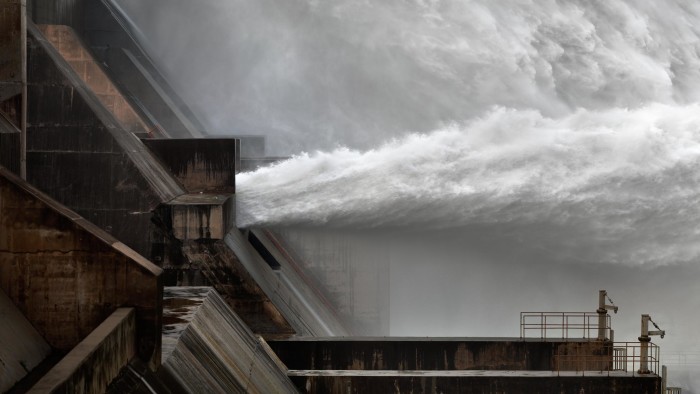Edward Burtynsky

Simply sign up to the Life & Arts myFT Digest -- delivered directly to your inbox.
Edward Burtynsky’s “Water” is his most ambitious project yet in a career devoted to imaging the impact of human activity on the earth. For five years Burtynsky, Canada’s best-known photographer, criss-crossed the world recording the ways we have used – and abused – the liquid on which life depends.
What he needed most for the project, besides energy and an extraordinary visual imagination, was an excellent head for heights. “I wanted to find ways to make compelling photographs about the human systems employed to redirect and control water,” he says. “I soon realised that views from ground level could not show the enormous scale of activity. I had to get up high into the air, to see it from a bird’s-eye perspective.”
Although Burtynsky took shots from man-lifts, cranes and even remotely from a robotic miniature helicopter, he worked mainly from conventional helicopters and light aircraft. He pointed his Hasselblad camera through a hole in the floor of a Cessna as it flew over the great discs, up to a mile in diameter, imprinted on the Texas Panhandle by “pivot irrigation”. He hung out of a helicopter with one door removed as it buzzed over the bizarre fieldscapes of Monegros, a dryland farming area in Aragón.
Burtynsky was born in 1955 into a Ukrainian immigrant family in St Catharines, south of Toronto. As a child he became fascinated by industrial images, looking at the General Motors factory where his father worked. “When I was 11, I got my first camera and a darkroom,” he says. “I immediately fell in love with photography and never looked back.” After studying photography at Ryerson University in Toronto, he threw himself into photographing mines, quarries, railways and factories. He also set up Toronto Image Works, a business including photo laboratory, digital imaging and new media training, where he is based.
Burtynsky began to think about a project on water in 2007, during a tour of gold mines in Australia, when the country was undergoing a severe drought. With dehydration dominating the local news – and people being made to drink up the precious glasses of water they had ordered in bars and restaurants – “Suddenly water took on a new meaning for me.”
After a year of research and reconnaissance Burtynsky was ready for action. At first he concentrated on still photography but soon found himself working at the same time on a feature-length documentary called Watermark (with moviemakers Jennifer Baichwal and Nick de Pencier, who were also behind his 2006 film Manufactured Landscapes), to be released this autumn.
He decided quite early in the project to put the images into six categories. “Distress” shows landscapes destroyed by human use of water. Most striking is the delta where the Colorado River once flowed into Mexico’s Gulf of California, before the great dams of the American Southwest began diverting its water to US agriculture and industry. Today, the delta’s ecosystem is a saline dead zone, though its branching structure of salty streams provided Burtynsky with amazing treelike images.
“Agriculture” claims a big slice of the project because farms consume 70 per cent of fresh water under human control. The stunning sequences of Texan and Spanish cultivation were taken after harvest and in winter. “The colour palettes available then – the browns and greys, yellows and reds – are much more interesting than in the growing season,” Burtynsky says.
“Aquaculture” looks at fish and crustacean cultivation, while “Control” captures the monumental infrastructure of dams and channels built to capture and move water around. “Waterfront” covers people living on or beside water. And finally “Source” looks at unspoilt mountain glaciers, rivers and streams – which, says Burtynsky, are “the first landscapes in over 30 years I have taken that focus specifically on pristine wilderness instead of the imposition of human systems upon it”.
As a child Burtynsky painted with great enthusiasm. Though no longer an active painter, he remains in love with the medium. “While executing the Water project, I was pleased to see images emerging that referenced some of my favourite painters, including Caspar David Friedrich and Jean Dubuffet,” he says.
But Burtynsky wants everyone viewing the photographs to bear in mind that they are all about water – and about the winners and losers when water is disrupted from its natural course.
“The moment water cannot find its own way back to the ocean or be absorbed by the ground, we are changing the landscape,” he observes. “Insects, plants, frogs, salamanders and countless other creatures, including people, have paid an enormous price because of our voracious appetite for water.”
——————————————-
Photographs by Edward Burtynsky, courtesy Nicholas Metivier Gallery, Toronto / Flowers, London
Clive Cookson is the FT’s science editor
To comment on this article, post below or email magazineletters@ft.com
——————————————-
‘Where I Stand: A Behind-the-Scenes Look at Edward Burtynsky’s Photographic Essay, Water’
Comments